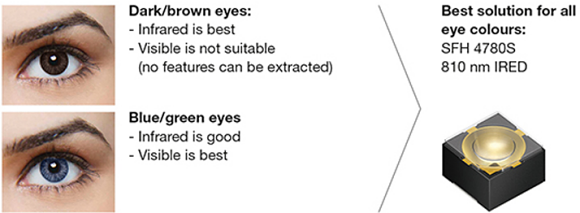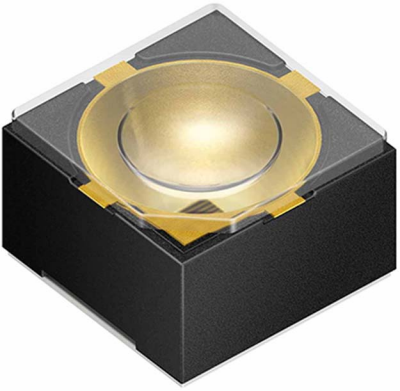
Introduction
The uniqueness of people is the basis for biometric identification methods. Fingerprint scanners and iris or facial recognition have been established for a long time for access control for sensitive areas.
Nowadays, smartphones, and tablets also need special protection, as their users increasingly carry out sensitive activities via their mobile devices. Compact optical biometric sensors for iris scanning are coming on as the biometric identification method of choice. An important requirement for this technology is infrared emitters with a suitable wavelength and performance.

Fig. 1: Higher security via biometrics, more and more often, smartphones and tablets contain sensitive information and therefore have to be well protected from unauthorized access. User identification by means of unmistakable body characteristics offers a safe and convenient alternative to passwords. In addition to fingerprint, facial, and voice recognition, iris scanners distinguish themselves as the next best biometric access solution for mobile devices.
Biometric Sensing
Our fingerprints, the patterns of our iris, the progress of the veins in our palm, or our voice are unique individual characteristics. In high security areas or in the military, the identification of authorized persons by means of the biometric sensing of such physical characteristics has been established for a long time. Fingerprint or iris scanners are also present at some entry checks.
A new field of application has now opened for biometrics when unlocking mobile devices. Such a protection becomes necessary as more and more people handle sensitive matters such as banking, purchases or their professional communications over smartphones or tablets. Many manufacturers view biometrics as a secure and convenient alternative to complex passwords.
Biometric sensors detect certain characteristics and compare them with previously stored patterns of the authorized person. A measure of their effectiveness is to make the risk as low as possible that non-authorized persons can gain access (false acceptance), and to enable a low rejection rate of authorized persons (false rejection).
Optical Biometric Sensors
Optical fingerprint sensors, for example, are found at some entry checkpoints. They consist of a light source and a camera sensor under a glass cover, onto which the finger is placed. The light falls onto the glass under a certain angle, so that only those beams are reflected to the sensor, which diffracts at the papillary lines of the placed finger.
A light-emitting diode (LED) or an infrared LED (IRED) serves as the light source. If the sensor is to be as inconspicuous as possible, IREDs with a wavelength of 850 nanometers (nm) should be used. Their light is barely visible to people, but it is still registered well by the camera sensors.
Some smartphones or tablets are also protected by fingerprint sensors, which are often capacitive systems. A weak point, however, is that the users themselves leave their fingerprints on the touch screens. Hackers have already cracked diverse smartphones with fingerprints taken from the display.
Facial recognition is also used for mobile devices. The built-in camera photographs the user and the software determines typical facial characteristics not subject to facial expression. However, the sensor becomes unreliable in poorly lit environments without additional lighting. Facial recognition sensors could already be outsmarted with photos, and they are often combined with voice recognition systems.
The identification of the iris pattern is rated up to now as being exceptionally reliable. The sensor illuminates one or both eyes with infrared LEDs, records an image of the iris with a camera, and determines its characteristic pattern.
Iris scanners are rated to be very reliable, compared to fingerprint sensors, as the iris pattern does not change with the age of the person and is also not subject to any external influences such as injuries. The rate of false rejections is clearly lower than that of fingerprint sensors. The risk of false acceptances is also extremely small, with about one in one million. However, hackers recently demonstrated the illusion of these scanners with iris patterns from photos. A possible solution is the evaluation software that checks the natural twitching of the iris. Currently, many manufacturers of mobile devices are turning to iris scanners as a new method for unblocking.
A retina scan senses the pattern of the blood vessels on the retina. The eye is illuminated with infrared laser light, while the person looks through the ocular of the scanner. Blood absorbs the laser light to a higher extent than the surrounding tissue, so that the blood vessels appear darker in the recording.
The smallest retina scanner known to date is approximately pocket size. Similar to retina scans, vein scanners also use characteristics from the interior of the body, which cannot be extracted from photos. They illuminate the palm with infrared light and register the reflected beams with a camera sensor. As blood absorbs infrared light to a higher extent than the surrounding tissue, the vein pattern typical for each person can be seen in the image. Efficient IREDs with a wavelength of 850 nm are suitable for the illumination. The security level of vein scanners is similar to the one of the iris scanners. Occasionally, they already serve for identification at cashpoints. In 2014, Fujitsu presented a laptop with an integrated vein scanner.
Iris Scanners For Smartphones And Tablets
Iris scanners stand out as the next best biometric solution for mobile devices. They promise a high reliability and the scanners can be designed in a very compact manner, as no minimum surface is necessary for the placement of a finger or of the hand. In addition to the reliable function, the most important requirements are low energy consumption and a compact design. In the mobile device, an iris sensor consists of a camera chip and an IRED for illumination of the eyes (see fig. 2).

Fig. 2: Function of an iris scanner in a smartphone. The eye is illuminated with infrared light and the characteristic iris pattern is read out from the camera image. A bandpass filter over the camera sensor now lets the wavelength of the infrared illumination pass through and guarantees a good signal-to-noise ratio, even with powerful ambient light.
The components can be placed at separate locations under the device cover. A special bandpass filter above the camera sensor only lets the wavelength for the light used for illumination pass and thus also guarantees a good signal-to-noise ratio even with powerful ambient light. The operating distance is approximately 20 cm to 35 cm.
The contrast of the recorded images is very important for the quality of the scanner, as the iris pattern can only then be securely identified. For brown eyes, the eye color most predominant worldwide, high-contrast recordings can only be achieved using infrared light. With blue and green eyes, the best results are achieved using visible light; however, infrared wavelengths also deliver good results (see fig. 3).

Fig. 3: Iris scanners require extremely high-contrast images in order to reliably identify the iris patterns. For brown eyes, this is best achieved through infrared light. With blue and green eyes, visible wavelengths deliver the best results; infrared light also yields good results. With 810 nm, high-contrast recordings can be realized for all eye colors.
The typical wavelengths for iris scanners are between 700 and 900 nm. Many experts currently set 810 nm as a good compromise in order to realize images with a high contrast for all eye colors. A further advantage of this wavelength is that it reduces the typical reflection from the cornea, which has an adverse effect on the iris recordings, to the minimum. Osram has recently extended its infrared wavelength spectrum and has developed the 810 nm IRED SFH 4780S (see fig. 4).

Fig. 4: The Oslux SFH 4780S, with a wavelength of 810 nm, enables reliable iris recognition in mobile devices for the first time. With a radiant intensity of 2900 mW/sr at 1 A, the IRED is the best current ratio of component size for better performance.
In addition to the wavelength, the amount of light falling onto the eyes is significant for the image contrast. Stationary devices therefore often use several LEDs. This is not possible in mobile devices, so that the optical performance and, in particular, the radiation characteristics of the IRED are important parameters for the quality of the sensor.
The SFH 4780S has an efficient thin film chip, in which two emission centers are realized with the help of nanostack technology. The Oslux housing enables very narrow radiation angles thanks to an internal reflector and a specially adapted integrated lens despite a low component height. The result is an IRED with a height of only 2.4 mm with a radiation angle of 20°, which delivers typical radiant intensity values of 2,900 mW/sr with a current of 1A.
As with all applications where eyes are subjected to infrared light, the guidelines for eye safety are also valid for iris scanners. The light performance that the eye receives over a certain period is significant. It can be controlled via the pulse duration or via the operating current. Specific indications for the standard-compliant design of optical designs can be found in the Osram application documents regarding eye safety and iris scanners.
IRED For Biometric Security
Optical biometric sensors benefit from the high availability of cost-effective camera sensors and powerful LEDs and IREDs. As has been shown with the example of the iris scanners, a good illumination of the body area to be sensed with a suitable wavelength is essential for a low error rate of the sensor.
This means that smartphones and tablets need to transfer sufficient brightness to the desired location using compact emitters. Therefore, not only high optical performances and new wavelengths are required, but also innovative housings that ensure the required beam characteristic.
About the Authors
Bianka Schnabel is the marketing manager of Infrared with a Focus on Consumer at Osram Opto Semiconductors. She started her professional career after graduating from the senior technical school with training as industrial manager at Siemens Semiconductors. Subsequently, she studied business management with a focus on marketing at the Verwaltungs und Wirtschaftsakademie (VWA) Ostbayern in Regensburg.
Since 2010, Dr Hubert Halbritter has worked at Osram Opto Semiconductors in the area of application engineering for infrared projects. Previously, he worked at the Darmstadt University of Technology in the Institute for High Frequency Technology specializing in Optical Telecommunications. He obtained his PhD in the area of Components for Optical Communications at Darmstadt University of Technology.
Related Stories
Ultrasound Fingerprint Biometric Touch Sensor Under Glass For Mobile and IoT Devices
Biometrics Market Revenue to Total $67 Billion Worldwide over the Next 10 Years
Synaptics Announces World's First Match-in-Sensor Fingerprint Authentication Technology
Fingerprint Sensors Market Worth $14,500.07 Million by 2020